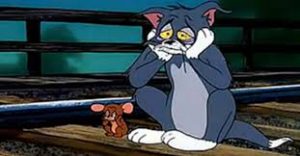 In “Cat’N’Mouse” by Steven Millhauser, there lies a certain familiar feel to the work. The work follows the antagonist, the cat, trying to capture (or, rather kill) the mouse that lives in the same vicinity as him. However, the mouse outsmarts the cat’s attempts to kill him. The cat and mouse duo can be seen in the 1940 cartoon titled “Tom and Jerry.” Throughout the cartoon series, they develop a love/hate relationship. Tom tries endlessly to capture Jerry, whilst Jerry responds to his threats with turning the plot against Tom (which is seen in “Cat’N’Mouse”). One of the themes associated with “Cat’N’Mouse” is ignorance versus intelligence.
In “Cat’N’Mouse” by Steven Millhauser, there lies a certain familiar feel to the work. The work follows the antagonist, the cat, trying to capture (or, rather kill) the mouse that lives in the same vicinity as him. However, the mouse outsmarts the cat’s attempts to kill him. The cat and mouse duo can be seen in the 1940 cartoon titled “Tom and Jerry.” Throughout the cartoon series, they develop a love/hate relationship. Tom tries endlessly to capture Jerry, whilst Jerry responds to his threats with turning the plot against Tom (which is seen in “Cat’N’Mouse”). One of the themes associated with “Cat’N’Mouse” is ignorance versus intelligence.
The mouse represents intelligence, as it is revealed to the readers that he reads and is educated. Whereas, the cat does not read, therefore, he represents ignorance. The cat’s plots against the mouse undoubtedly fail every time as the mouse outwits his every plan. Even though he fails every time, the cat always chases after the mouse.
The cat understands that the mouse will always outwit him, but this tormenting knowledge serves only to inflame his desire to catch the mouse. (14)
The question arises as to why the cat has such a resentment against the mouse. Why must he feel the need to capture the mouse? Is it the natural instincts? Perhaps, it is the natural instincts of predator versus prey that leave us to not question the decision. It remains clear that the mouse represents intelligence within the story and the cat representing its counterpart.
The mouse’s disdain for the cat is precise and abundant: he loathes the soft, heavy paws with their hidden hooks, the glinting teeth, the hot, fish-stinking breath. At the same time, he confesses to himself a secret admiration for the cats coarse energy and simplicity. It appears that the cat has no other aim in life than to catch the mouse. (6)
He understands that his rage is not the rage of hunger and he wonders whether the mouse himself is responsible for evoking this savagery, which burns in his chest like indigestion. He despises the mouse’s physical delicacy, his weak arms thin as the teeth of combs, his frail, crushable skull, his fondness for books and solitude. At the same time, he is irritably aware that he admires the mouse’s elegance, his air of culture and languor, his easy self-assurance. Why is he always reading? In a sense, the mouse intimidates the cat: in his presence, the cat feels clumsy and foolish. He thinks obsessively about the mouse and suspects with rage that the mouse frequently does not think about him at all, there in his brown room. (9)
The cat, even though his size and predator tendencies place him at the top of the food chain, is left vulnerable and challenged compared to his rival.
Although he knows that he will never catch the mouse, who will forever escape into his mousehole a half inch ahead of the reaching claw, he also knows that only if he catches the mouse will his wretched life be justified. (14)
Throughout the story, the author evokes a sense of pity towards the cat. He will never outwit the mouse, yet he tries hopelessly, which only ends in his own demise. In addition, the author portrays the mouse as being just as melancholy and lonely as the cat.

I agree that the mouse is showing to be a little bit smarter than the cat is showing! I think is is especially shown in the scene where the cat is putting the mechanical mouse with the explosives in the mouse hole but the mouse send it right back out!
I think the author definitely trying to evoke pity for both characters. But I also think he was trying to prove how useless somethings become without an opposing force. Some conflicts were never meant to be solved. I think the tom and jerry metaphor perfectly summarizes it